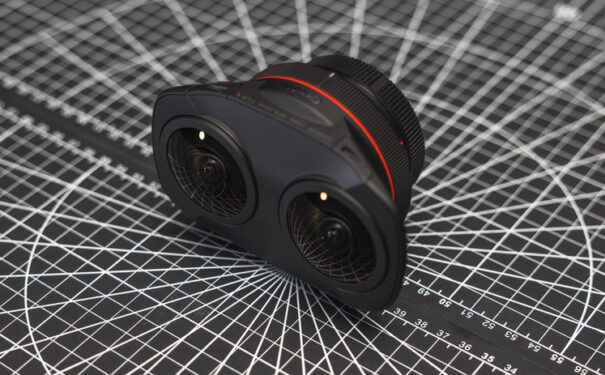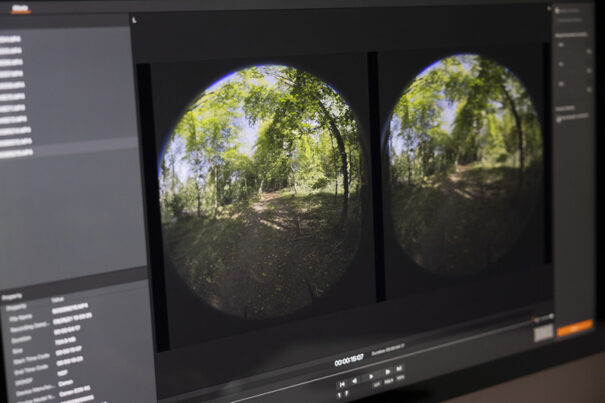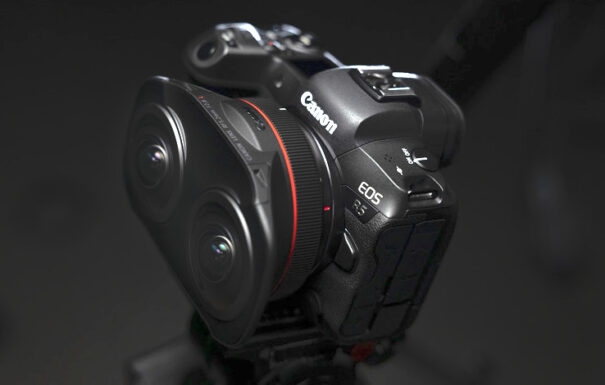Canon looks to revolutionize virtual reality with EOS VR and RF 5.2 mm f/2.8L Dual Fisheye lens
The new EOS VR system from Kanon, featuring the RF 5.2mm f/2.8L Dual Fisheye lens, has been developed in response to the demand for 180° VR (3D) content.
With EOS VR, Canon aims to simplify the process of recording 180° VR stereoscopic images, as well as their post-production. At the heart of this proposal is the Canon RF 5.2 mm f/2.8L Dual Fisheye, Canon’s first interchangeable VR lens. The solution features two front-facing fisheye lenses, with an ultra-wide angle of view of 190 degrees, which is the basis of its ability to capture stereoscopic VR images.
Canon’s optical design allows the projection of two images onto the camera’s single sensor, thus achieving correct synchronization directly from the camera. According to the manufacturer, “subtle variations” in both image quality and exposure can be avoided. Additionally, the two electromagnetic diaphragms (EMD), one for each lens, can be controlled to maintain consistent exposure on the sensor, which helps reduce gradation in post-production.
This compact lens features a smart folding optical design and a 60mm baseline length for a natural-looking view. Designed to work with compatible cameras within the VR system, such as the Canon EOS R5, the system offers both the portability and familiarity of the EOS System.
 Versatility for different situations
Versatility for different situations
The Canon RF 5.2mm f/2.8L Dual Fisheye stereo lens incorporates the familiar red ring, identifying it as a professional L-series lens that uses two UD lenses for each lens, helping to produce sharp images from one edge of the image to the other. The SWC coating on the Canon RF 5.2mm f/2.8L Dual Fisheye lens allows shooting with sun in the frame, suppressing flare and ghosting, a frequent situation when working on VR recordings.
In addition, thanks to the inclusion of a gelatin filter holder on the rear of the lens, users of the Canon RF 5.2mm f/2.8L Dual Fisheye lens can use third-party ND gelatin filters to maintain “normal” shutter speeds and apertures when shooting in bright conditions. The MF Peaking function of the EOS R5 provides easy manual focus assist, which highlights focused areas.
In addition, RF 5.2 mm f/2.8L Dual Fisheye is ready to work with high dynamic range using Canon Log / Log 3. Its f/2.8 aperture, together with the EOS R5′s ability to use high ISO sensitivities, gives content creators the opportunity to shoot in a wide range of situations.
 Post-production facilities
Post-production facilities
Capturing both images through the same sensor allows Canon software or plug-in to accurately convert the captured dual circular fisheye format to the standard 180° VR format, ready for further editing in Adobe Premiere Pro or viewing with VR goggles.
The image conversion process is usually one of the most complicated tasks in VR content creation, but thanks to the new EOS VR Utility application and the EOS VR plug-in for Adobe Premiere Pro, Canon says it is “very easy” to go from a double circular fisheye image to a side-to-side equirectangular projection 180° VR format. With these additional solutions, videos and photos can be “easily” processed, and exported in different resolutions and (professional) codecs, up to an 8K file size for video content, designed for post-production editing and/or final playback in VR-capable virtual reality glasses.
Hat Ihnen dieser Artikel gefallen?
Abonnieren Sie unsere Füttern Und es wird Ihnen an nichts fehlen.
















